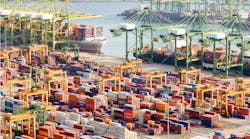Download this article in PDF format.
Supply chain woes have plagued companies, procurement professionals, transportation providers and logistics companies for much of the year and it doesn’t look like the challenges are going to fade anytime soon. And while some of the issues have ebbed and flowed—lumber and chicken wing shortages one month, followed by a dearth of ketchup and gas the following month—core problems like the semiconductor shortage have largely remained in place throughout the year.
“Right now, every single end market for semiconductors is up simultaneously; I’ve been in this industry 27 years, I’ve never seen that happen,” Marvell Technology’s CEO Matt Murphy said at a recent CNBC event. “If it stays business as usual, and everything’s up and to the right, this is going to be a very painful period, including in 2022 for the duration of the year.”
While several chip producers have announced plans to expand factory capacity, Murphy told the audience that these facilities won’t be up and running until 2023 and 2024. “We’ve always gone through cycles of ups and downs, where demand has exceeded supply or vice versa,” AMD’s Lisa Su said at a recent industry event, as reported by CNBC. “This time, it’s different.” She expects the first half of 2022 to be “likely tight,” with the second half less severe as manufacturing capacity opens.
Feeling the Strain Down the Line
For some sectors, the current supply chain challenges may not wane until the ongoing labor constraints are solved. “The everyday items and services we’ve all come to take for granted — buying half-and-half, getting the kitchen repainted, buying a new couch — have been disrupted by the Covid-19 pandemic, and more specifically, the unpredictable delta variant,” Susan Caminiti writes in “Lack of workers is further fueling supply chain woes.”
“As we’ve all been forced to acknowledge over the past 18 months,” she continues, “when one point in the supply chain gets disrupted or delayed, the reverberations are felt down the line.”
Caminiti explains that labor shortages at every part of the supply chain are having an impact on companies and also impacting economic growth.
“As Americans fume, supply headaches that were viewed as temporary when the coronavirus pandemic began now are expected to last through 2022,” David Lynch writes in “Inside America’s broken supply chain.”
The cargo vessels anchored off California’s coast—waiting to get into port and unload their goods—serve as one very visible example of just how difficult it may be to get the world’s supply chains back on track. “It’s going to get worse again before it gets better,” SEKO Logistics’ Brian Bourke told The Washington Post. “Global supply chains are not built for this. Everything is breaking down.”
Sneakers to Furniture to Cars
Facing these realities, both organizations and governments alike are looking for new ways to mitigate the problem sooner rather than later. There’s also early talk of lifting Trump-era tariffs, for example, which effectively impacted about $350 million in Chinese-made goods. “Despite the change in administrations, those duties remain in place. American importers have paid more than $106 billion to cover the cost of those levies to date, and many of them are now facing skyrocketing shipping costs,” CNN reports.
“Now the pressure on the Biden administration to address the issue is ramping up, as supply chain problems are getting worse,” CNN continues, “resulting in shortages and higher prices for everything from sneakers to furniture to cars.”









